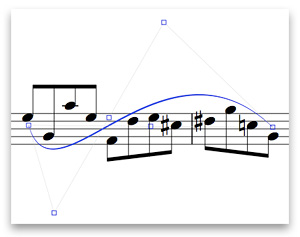Special notations
 Sibelius lets you produce scores so stunning, they’re virtually works of art. Slurs in Sibelius are the most beautiful and controllable of any program. Stemlets and beamed rests can be added and positioned instantly, as can arpeggio lines. Sibelius will even include cautionary accidentals automatically—helping you to produce performance-ready scores every time.
Sibelius lets you produce scores so stunning, they’re virtually works of art. Slurs in Sibelius are the most beautiful and controllable of any program. Stemlets and beamed rests can be added and positioned instantly, as can arpeggio lines. Sibelius will even include cautionary accidentals automatically—helping you to produce performance-ready scores every time.
 Slurs
Slurs
Sibelius has the most beautiful and controllable slurs of any program. Their default design and position is superior in all kinds of situations. You can also adjust their shape using no fewer than six handles, and alter their thickness individually. Various Engraving Rules options let you control the default height and shoulder for different slur lengths.
Cautionary accidentals
Sibelius automatically adds cautionary accidentals wherever they're needed, so you'll get fewer wrong notes in performance. The default setting should do just what you want, but as usual we've included various options you can tweak—where to use cautionary accidentals (e.g. up to the end of the next bar, between different octaves or voices, or when tying notes between systems), and whether to draw them in parentheses.
Repeat bars

You can add 1-, 2-, and 4-bar repeats from the Keypad, which play back just like anything else. Multiple repeat bars can also be automatically numbered (without using a plug-in), so performers won't lose their place.
Jazz articulations and slashes

You can quickly add scoops, falls, doits, and plops to notes from the Keypad—no need to use symbols. Like other articulations, they position automatically and transpose with the notes, but you can also move them individually. Jazz articulations even play back on suitable MIDI devices (e.g. Garritan Jazz and Big Band).
Slashes also stay put when the rest of the music transposes, making rhythm charts quicker to produce. Other jazz improvements include enhanced chord symbols, which you can input faster than ever from your computer or MIDI keyboard.
 Modern notations
Modern notations
Sibelius includes optional stemlets ('half-stems') for rests in beamed groups. You can either use stemlets throughout the score, or add them to individual rests from the Keypad. There are various other options for beamed rests too, even without stemlets.
Sibelius also has automatic “feathered” beams, for showing brief accels/rits. Again, you choose them from the Keypad, and they even work on two-note tremolos.
Other notations
You can add wiggly arpeggio lines to spread chords instantly, straight from the Keypad. They're attached to notes, so Sibelius automatically allows room for them, and they transpose with the notes too. Use a normal wiggly line, or one with an up- or down-pointing arrow.
You can also make ties break across time signatures, by being drawn behind them. In fact, you can make any object go in front of or behind any other, like in many drawing programs. This is particularly useful for putting imported graphics in front of or behind staves.
Articulations are automatically drawn inside or outside slurs or tuplets depending on the situation, with a host of subtle options. You can also reposition multiple articulations on the same note individually rather than all at once.


